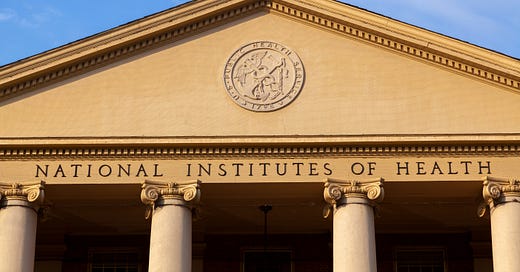It started as World War II was ending 80 years ago—a visionary, federally-funded program of bio-medical research at university laboratories, creating scientific breakthroughs that have saved millions of lives, developed new medications and vaccines, and led to American superiority in such technologies as artificial intelligence (AI) and quantum computing. This groundbreaking program, funded by the National Institutes of Health (NIH), showed every sign of blasting its way into new worlds of scientific discovery until…the inauguration of President Donald Trump on January 20, 2025.
American history then changed. Claiming we were entering a “Golden Age of America,” Trump instead opened a new, brutally challenging chapter by launching a fast-spinning, drastic overhaul of the entire government, which included, among many other reckless actions, a major, arbitrary cut in NIH’s staff and budget. The almost immediate effect, felt throughout the world, was a sudden paralysis in scientific research, enveloped in fear and wonder. Its $47 billion annual budget, once the largest contributor to bio-medical research in the world, was frozen, cancelled, or cut, and 1,300 of its staff of talented research and teaching personnel were fired.
“The extraordinary success that has been American science,” wrote Paul Darren Bieniasz, a British-American professor of retrovirology at Rockefeller University, “makes it especially distressing to now witness its destruction.” One reason is that once such research is interrupted, it is hard to restart. Bieniasz, whose specialty is HIV/Aids, is convinced that unless federal funding is quickly restored (an unlikely prospect), “future life-saving medicines may never be invented.”
At the moment, life on the NIH campus in a Washington DC suburb has slowed to a crawl. Those who remain seem in no hurry to rush to a lab. Many, wandering about, are confused and frightened, hoping their medical work may one day be resumed, but doubtful. Some live with memories of another era. One researcher spoke of the comparison between NIH’s first grant of $92,000 to the University of Utah in 1946 and its more recent grant of $9.2 billion to Harvard for cancer research and hospital maintenance in the Boston area, but the Harvard grant now dangles in doubt, no one certain when or if it will ever be provided.
Dr. Francis Collins, who managed busy, exciting times at NIH for a dozen years, spoke with pride of this unique public/private mix of federal grants to private research centers. Because of the nature of scientific research—“inherently inefficient” with “outcomes unpredictable,” according to Bieniasz—private funding was always problematic. With the birth of the Cold War after World War II, the US government, mindful of a Soviet threat, pumped money into university research to satisfy the needs of the nation’s strategic interests, which quickly ballooned from weapons to infectious diseases and then to heart care, diabetes, and many other ailments. Public funding became essential for public health care, and America led the world in scientific research. Twenty of the world’s top thirty universities were located in the United States. Most Nobel prizes in science were awarded to Americans. Half of the world’s medicines were invented here.
But with Trump having slashed the NIH budget, such scientific accomplishments have become the triumphs of a once-glorious past. Not much is left. A leading environmental magazine has now sharply reduced the number of articles submitted for publication, throwing a wet blanket over environmental research. A peer-reviewed NIH project to find ways of producing better vaccines was prematurely ended without justification. One group of scientists specializing in infectious disease has been ordered to stop all research, as of 5 p.m. on April 28, 2025, on ebola, SARS-Cov2, and eastern equine encephalitis. What happens if there is an outbreak of ebola in central Africa, as once there was? Would American scientists work to stop it from spreading to the United States? Not if there is no further funding.
Closer to home, what effect does the NIH cutoff have on the busy Washington physician? It has proven to be as devastating to her as it has been to NIH. “Patients are most concerned that they will lose their vaccine access,” said Dr. Kristin Thomas, knowing her waiting room is now filled with uncertainty. She’s been busy doing immunity blood tests on “many of my patients, so they can get boosters.” But, she asserts with refreshing defiance, “we cannot and will not be dogged by DOGE.”
However, short of federal funding (which is now the case), American science has obviously been throttled. For how long? With what effect? No one really knows. It’s too serious a predicament for easy, glib judgments. What is known is that this generation of the American scientist has now been silenced, his or her research stalled by the decision not of another scientist but of a mindless politician bowing before a presidential whim. What about the next generation? Will it be able to catch up to and contain the next killer virus, now being hatched in a faraway marketplace?
Think about it.
Marvin Kalb, Murrow professor emeritus at Harvard, former network correspondent at CBS and NBC, and author of the recently-published A DIFFERENT RUSSIA: Khrushchev and Kennedy on a Collision Course.





It is impossible to predict how many humans will be negatively impacted by the "policies" of the Republican party. We can say with a great deal of certainty, based on our recent experience with COVID, that there is no amount of suffering and death that will make them change course. Whether it's measles, bird flu, or something completely new, it's a certainty we will be less prepared to respond. Republicans have become the party of sickness and death.
All this for a stinking tax break for the top 10%. Simply disgusting.